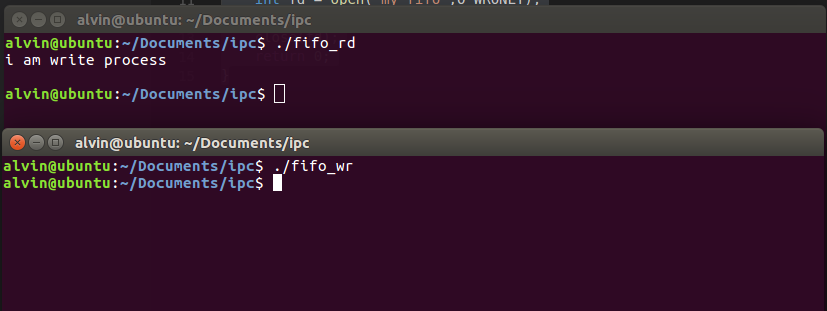继上篇文章分析了进程间通信管道的机制和特性,本文将从命名管道(FIFO)介绍进程间通信。
1、命名管道(FIFO)
管道应用的一个重大限制是它没有名字,只适合具有亲缘性质的进程之间通信。命名管道克服了这种限制,FIFO不同于管道之处在于它提供一个路径名与之关联,以FIFO的文件形式存在于文件系统中。这样,即使与FIFO的创建进程不存在亲缘关系的进程,只要可以访问该路径,就能够彼此通过FIFO相互通信(能够访问该路径的进程以及FIFO的创建进程之间),因此,通过FIFO不相关的进程也能交换数据。
2、创建一个命名管道
#include <sys/types.h> #include <sys/stat.h> int mkfifo(const char *pathname, mode_t mode);
3、操作命名管道
FIFO在文件系统中表现为一个文件,大部分的系统文件调用都可以用在FIFO上面,比如:read,open,write,close,unlink,stat等函数。但是seek等函数不能对FIFO调用。
可以调用open函数打开命名管道,但是有两点要注意
1)不能以O_RDWR模式打开命名管道FIFO文件,否则其行为是未定义的,管道是单向的,不能同时读写;
2)就是传递给open调用的是FIFO的路径名,而不是正常的文件
打开FIFO文件通常有四种方式:
open(pathname, O_RDONLY); //1只读、阻塞模式
open(pathname, O_RDONLY | O_NONBLOCK); //2只读、非阻塞模式
open(pathname, O_WRONLY); //3只写、阻塞模式
open(pathname, O_WRONLY | O_NONBLOCK); //只写、非阻塞模式
注意阻塞模式open打开FIFO:
1)当以阻塞、只读模式打开FIFO文件时,将会阻塞,直到其他进程以写方式打开访问文件;
2)当以阻塞、只写模式打开FIFO文件时,将会阻塞,直到其他进程以读方式打开文件;
3)当以非阻塞方式(指定O_NONBLOCK)方式只读打开FIFO的时候,则立即返回。当只写open时,如果没有进程为读打开FIFO,则返回-1,其errno是ENXIO。
4、阻塞式命名管道
Read进程代码如下:
#include <unistd.h> #include <sys/types.h> #include <sys/stat.h> #include <fcntl.h> #include <stdio.h> int main(int argc, char* argv[]) { int ret = mkfifo("my_fifo",0777); if (ret == -1) { printf("make fifo failed! "); return 1; } char buf[256] = {0}; int fd = open("my_fifo",O_RDONLY); read(fd,buf,256); printf("%s ",buf); close(fd); unlink("my_fifo"); return 0; }
Write进程代码如下:
#include <unistd.h> #include <sys/types.h> #include <sys/stat.h> #include <fcntl.h> #include <stdio.h> #include <string.h> int main(int argc, char* argv[]) { char *buf = "i am write process "; int fd = open("my_fifo",O_WRONLY); write(fd,buf,strlen(buf)); close(fd); return 0; }
首先启动read进程,创建fifo,当前目录下会生出一个名字为“my_fifo”的文件,然后启动write进程,运行结果如下:

结论:当write进程没有以O_WRONLY模式open命名管道时,read进程在以O_RDONLY模式open命名管道的时候会阻塞。反过来也是这样。
5、非阻塞式命名管道
Read进程代码入下:
#include <unistd.h> #include <sys/types.h> #include <sys/stat.h> #include <fcntl.h> #include <stdio.h> int main(int argc, char* argv[]) { int ret = mkfifo("my_fifo",0777); if (ret == -1) { printf("make fifo failed! "); return 1; } char buf[256] = {0}; int fd = open("my_fifo",O_RDONLY | O_NONBLOCK);
// sleep(5); read(fd,buf,256); printf("%s ",buf); close(fd); unlink("my_fifo"); return 0; }
Write进程代码如下:
#include <unistd.h> #include <sys/types.h> #include <sys/stat.h> #include <fcntl.h> #include <stdio.h> #include <string.h> int main(int argc, char* argv[]) { char *buf = "i am write process "; int fd = open("my_fifo",O_WRONLY | O_NONBLOCK); write(fd,buf,strlen(buf)); close(fd); return 0; }
直接启动Read进程,open函数将不会阻塞,read函数读取到0个字节数据,程序退出。
将sleep(5)的注释去掉,再次启动Read进程,马上启动Write进程,Read进程会读取到Write进程写入fifo的数据并打印,然后退出。
结论:flags=O_RDONLY|O_NONBLOCK:如果此时没有其他进程以写的方式打开FIFO,open也会成功返回,此时FIFO被读打开,而不会返回错误。
经测试:flags=O_WRONLY|O_NONBLOCK:立即返回,如果此时没有其他进程以读的方式打开,open会失败打开,此时FIFO没有被打开,返回-1。